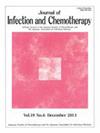Infective native aortic and iliac artery aneurysms: Clinical profiles and short-term outcomes from a single-center cohort
IF 1.9
4区 医学
Q3 INFECTIOUS DISEASES
引用次数: 0
Abstract
Introduction
Infective native aortic and iliac artery aneurysms, although rare, have high mortality rates of 21%–44 %. Diagnosis is often delayed owing to nonspecific symptoms. Treatment includes surgical intervention and antimicrobial therapy. This study aimed to describe the clinical characteristics and short-term outcomes of 32 patients with infective aneurysms at a single center.
Methods
This retrospective study, conducted at the Saitama International Medical Center from January 2011 to December 2020, included patients diagnosed with infective native aortic and iliac artery aneurysms. The patients’ clinical data, microbiological and radiological findings, treatment methods, and outcomes were collected and analyzed.
Results
Of the 32 patients, 56.3 % presented with fever (≥37.5 °C) and 87.5 % exhibited nonspecific symptoms, such as pain and loss of appetite. Blood cultures were positive in 18 patients (58.1 %), with Staphylococcus aureus being the predominant pathogen, isolated in 11 patients. Pathogens in 5 of the 11 cases (45 %) were resistant to methicillin. Surgery was performed in 75 % of patients, with 20 undergoing open surgical repair (OSR) and 4 undergoing endovascular treatment (EVT). The 1-year mortality rates of the patients who underwent OSR and EVT were 23.5 % (4/17) and 0 % (0/4), respectively. Postoperative infection-related complications occurred in 25 % of patients who underwent OSR. For nonsurgical patients, the 30-day and 1-year mortality rates were 25 % (2/8) and 85.7 % (6/7), respectively.
Conclusion
The findings of this study highlight the high mortality rates associated with infective aneurysms. S. aureus was the predominant pathogen, differing from trends observed in other Asian regions.
求助全文
约1分钟内获得全文
求助全文
来源期刊

Journal of Infection and Chemotherapy
INFECTIOUS DISEASES-PHARMACOLOGY & PHARMACY
CiteScore
4.10
自引率
4.50%
发文量
303
审稿时长
47 days
期刊介绍:
The Journal of Infection and Chemotherapy (JIC) — official journal of the Japanese Society of Chemotherapy and The Japanese Association for Infectious Diseases — welcomes original papers, laboratory or clinical, as well as case reports, notes, committee reports, surveillance and guidelines from all parts of the world on all aspects of chemotherapy, covering the pathogenesis, diagnosis, treatment, and control of infection, including treatment with anticancer drugs. Experimental studies on animal models and pharmacokinetics, and reports on epidemiology and clinical trials are particularly welcome.
 求助内容:
求助内容: 应助结果提醒方式:
应助结果提醒方式:


